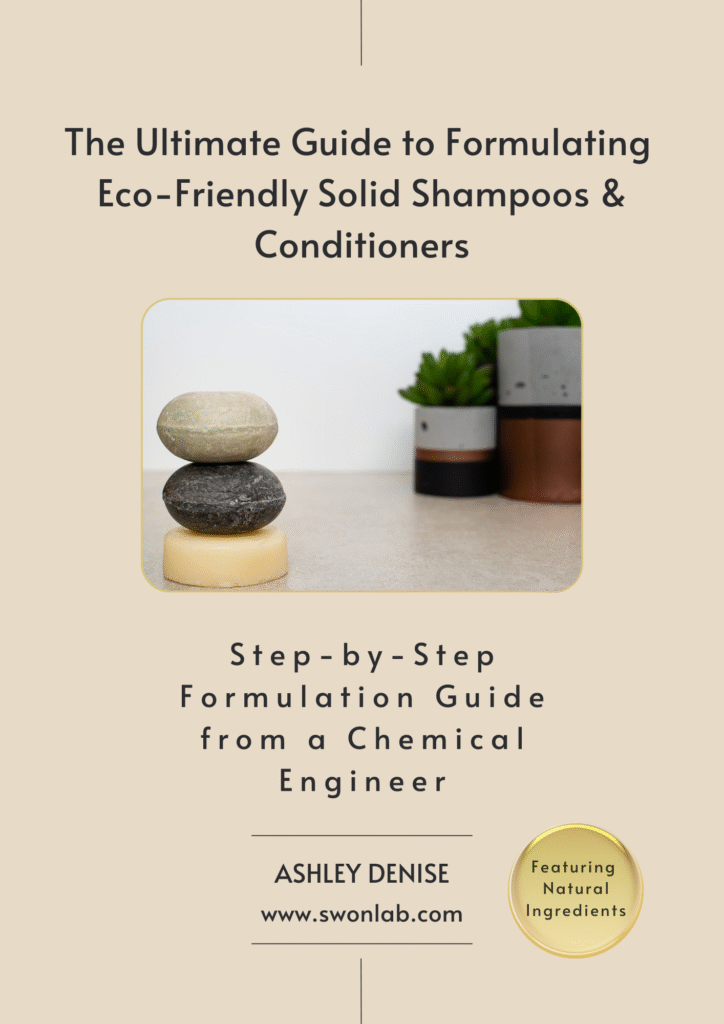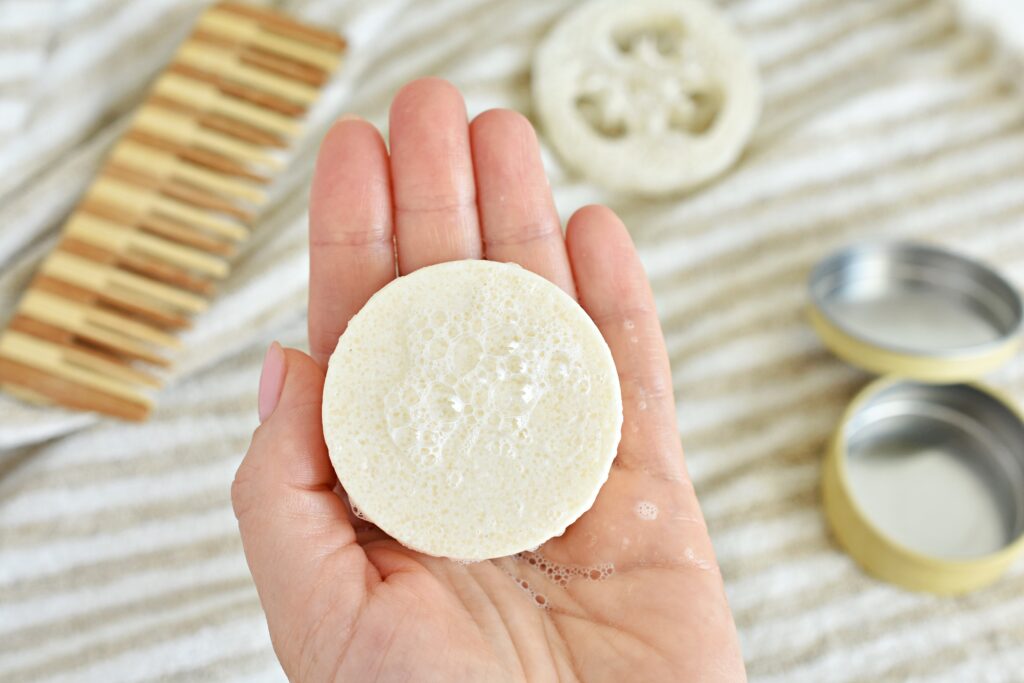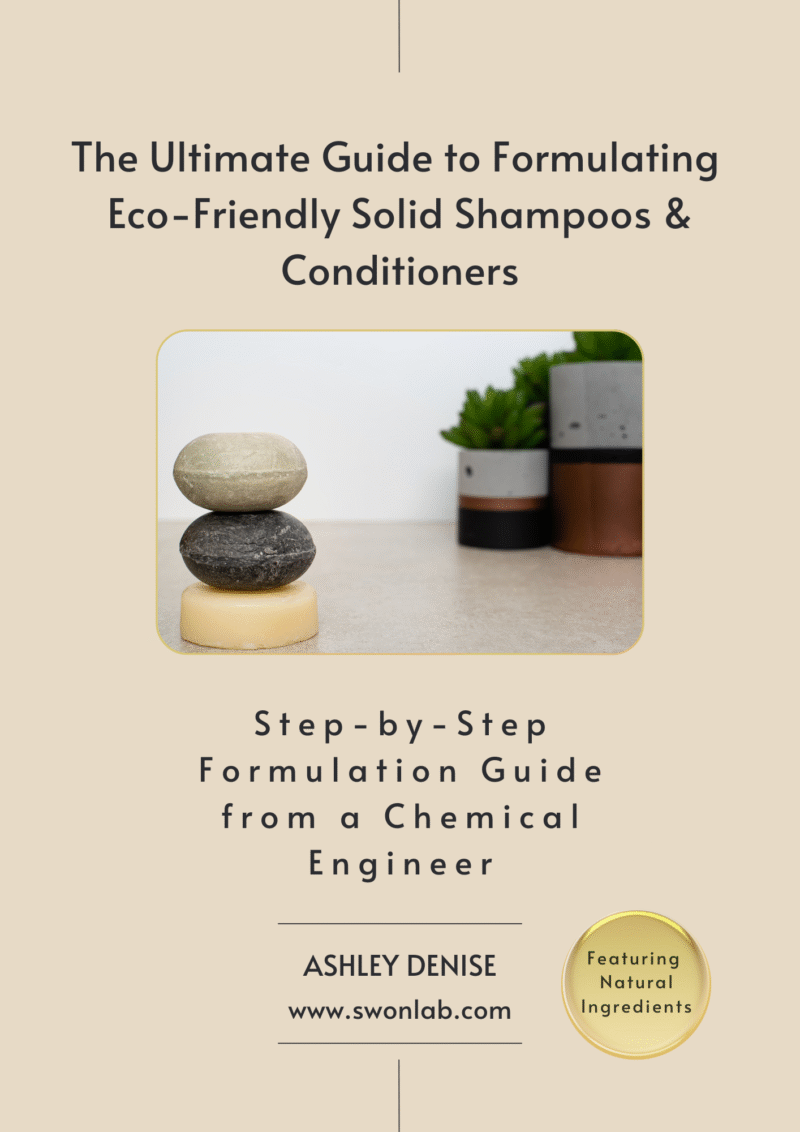In the world of solid shampoo bars, not all surfactants are created equal — and one ingredient consistently stands out from the crowd: Sodium Cocoyl Isethionate (SCI). Often called the “baby foam” surfactant, SCI is loved by formulators for its creamy lather, gentle cleansing power, and luxurious skin feel. But what makes it such a game-changer in solid haircare products? In this post, we’ll explore the science behind SCI, how it performs in formulations, and why it’s often the go-to choice for premium, scalp-friendly shampoo bars.
Whether you’re new to formulating or ready to refine your recipe, this guide shows how to use sodium cocoyl isethionate shampoo bar systems for gentle, high-performance cleansing.
Table of Contents
1. Introduction – What’s So Special About SCI Anyway?
Solid shampoo bars have exploded in popularity — and for good reason. They’re compact, travel-friendly, waterless, and aligned with the growing zero-waste movement. For conscious consumers and indie formulators alike, they offer a more sustainable and innovative alternative to traditional bottled shampoos.
But here’s the secret to a truly successful bar: the surfactant system. While many ingredients play supporting roles, the surfactant you choose can make or break the final product. And among the countless options out there, Sodium Cocoyl Isethionate (SCI) has become a favorite — not just for its mildness, but for the rich, creamy foam it delivers without compromising scalp health.
In this article, we’ll dive deep into why SCI stands out, how it performs in solid formats, and what makes it a top pick for formulators who want results without harshness.

📘 Want to Dive Deeper Into SCI and Solid Shampoo Bar Formulation?
Our Solid Shampoo & Conditioner Bar Formulation Guide goes beyond the basics — with 170+ pages of science-backed insights, ingredient breakdowns, and professional formulas tailored to different hair types.
If you're serious about crafting high-performance bars with SCI, this guide is your ultimate companion.
2. The Chemistry of SCI – What It Is and How It Works
SCI, short for Sodium Cocoyl Isethionate, is an anionic surfactant derived from coconut oil. It belongs to the isethionate family — a group of ultra-mild cleansing agents prized for their low irritation potential and creamy foam texture. Unlike harsh sulfates like SLS or SLES, SCI is designed to be gentle on the scalp and skin while still providing effective cleansing.
In technical terms, SCI is the sodium salt of the ester of coconut fatty acid and isethionic acid. Its structure makes it partially water-dispersible rather than truly water-soluble — meaning it doesn’t dissolve like salt, but it can be effectively suspended or melted into formulations with proper technique.
What formulators love most about SCI is the sensory experience it creates: a soft, cushiony lather that feels luxurious on the skin and rinses clean without that “squeaky clean” stripped feeling. Thanks to this balance, it’s often used in baby shampoos, sensitive skin products, and yes, high-performance solid shampoo bars.
📌 Safety Verdict – What Do Experts Say About SCI?
The Cosmetic Ingredient Review (CIR) Expert Panel has looked at SCI twice:
- 1993 original assessment – concluded SCI is “safe for use in cosmetic formulations at 50 % in rinse-off products and 17 % in leave-on products.” cir-safety.org
- 2013 re-review (extended to 12 isethionate salts) – kept the same verdict but dropped hard percentage caps, stating the salts are “safe in present practices of use and concentration when formulated to be non-irritating.” During that meeting the Panel noted the highest concentration then reported in a rinse-off product was 53 %, essentially the same level they had already cleared. cir-safety.org.
🧪 Formulator Tip:
SCI itself is mild, but that doesn’t mean every formula containing it will be.
To stay within safe limits, always calculate the actual ASM in your recipe (not just the raw % of SCI used) — especially when working with flakes or powders containing >80% actives.
3. Why It’s Ideal for Solid Shampoo Bars
Formulating a liquid shampoo gives you plenty of flexibility. You’re working with water, a blend of surfactants, and additives that can be adjusted with relative ease. But solid shampoo bars? That’s a whole different challenge and it’s exactly where SCI shines.
Because SCI is waterless by design, it fits beautifully into solid formats. It doesn’t require solubilizers to function, and unlike some other surfactants, it retains its mildness and performance even in anhydrous systems. When properly blended, it produces rich, creamy foam that gives the user an indulgent sensory experience, something many solid bars fail to deliver.
But the magic isn’t just about the lather. SCI also contributes to:
Bar hardness and durability — reducing mushiness over time
Lower irritation — thanks to its gentle cleansing properties
pH flexibility — allowing formulators to stay within scalp-friendly acidic ranges (4.5–5.5)
Let’s not forget how it compares to common alternatives:
❌ Sodium Lauryl Sulfate (SLS): can be harsh, drying, outdated
⚠️ Sodium Coco Sulfate (SCS): foamy but can be more irritating
✅ SCI: low irritation index, luxurious foam, better user satisfaction
This unique combination of functionality, aesthetics, and skin-friendliness makes SCI one of the most reliable choices for crafting modern, high-performance shampoo bars — whether you’re formulating for sensitive scalps, curly hair, or eco-conscious markets.
4. Formulation Benefits – What Makes It So Loved?
Sodium Cocoyl Isethionate (SCI) is more than just “the gentle one” – it’s a formulator’s secret weapon for creating shampoo bars that feel luxurious and perform like a dream. Here’s why it earns such a loyal fan base among skincare chemists and indie brand owners alike:
Creamy Foam Without Harshness
SCI produces a dense, cushiony lather that rivals even sulfate-based systems – but without the irritation. That luxurious foam improves the perceived quality of the product and gives users a premium sensory experience. It’s often described as “buttery” or “silky” — a stark contrast to the stripping squeaky-clean feel of harsher surfactants.
Mild Yet Effective Cleansing
Its molecular structure enables SCI to gently remove dirt and sebum without damaging the scalp barrier. This makes it ideal for:
Sensitive scalps
Color-treated or curly hair
Frequent-wash users (e.g., athletes or oily scalps)
Unlike many surfactants that compromise skin barrier function, SCI helps maintain it — a quality supported by dermatological studies on isethionates’ irritation index.
Compatibility with Other Surfactants
SCI works beautifully in synergistic surfactant systems, especially when you’re building a foundational formula using common co-surfactants like CAPB and APGs — as explained in our beginner’s surfactant guide.
CAPB (Cocamidopropyl Betaine) → enhances foam & reduces irritation
SCS (Sodium Coco Sulfate) → boosts lather but needs balancing
APGs (Alkyl Polyglucosides) → natural non-ionic surfactants for added mildness
These blends allow you to fine-tune your bar’s performance – foam, cleansing strength, rinse feel – without compromising scalp health.
Bar Structure & Aesthetic Appeal
Because SCI is solid at room temperature, it adds structure to your bar. It helps create bars that are:
Hard and long-lasting
Non-sticky
Easy to unmold and package
In short, SCI contributes to both formulation performance and finished product aesthetics – and that’s why it’s loved by those who want to formulate products that are both effective and elegant.
5. How to Use SCI – Percentages, Blending & Compatibility
Knowing that Sodium Cocoyl Isethionate (SCI) is mild, foamy, and beloved is great, but how do you actually use it well in a shampoo bar? Let’s break it down.
Usage Rates: From Mild to Max Foam
In beginner-friendly formulas, SCI is often used at 30–40%. But for richer foam and sulfate-free cleansing, it can go much higher.
In fact, SwonLab’s advanced solid shampoo bars include up to 60% SCI, carefully balanced with amphoteric surfactants and conditioning agents.
| Shampoo Bar Type | Recommended SCI % |
| Daily gentle bar (normal hair) | 25–30% |
| Oily scalp or deep-cleansing bar | 30–45% |
| High-foam premium sulfate-free bar | 50–60% |
⚠️ The higher your SCI content, the more important it becomes to balance the formula with pH control, emulsifiers, and mild co-surfactants like CAPB.
Many DIY shampoo bar recipes get popular online, but often ignore surfactant chemistry or pH balance.
Here’s how to spot (and fix) those common mistakes.
Pairing with Other Surfactants
SCI rarely works alone in high-performance bars. Instead, it shines in synergistic blends:
| Surfactant | Why It’s Used |
| CAPB (Cocamidopropyl Betaine) | Reduces irritation, enhances foam softness |
| SCS (Sodium Coco Sulfate) | Increases foam but can raise irritation |
| APGs (e.g. Decyl Glucoside) | Adds mildness and eco-cert appeal |
🔸 Pro tip from the SwonLab guide: This bar combines SCI 59.5% + CAPB 7% + APGs 9% (combined) with structural support from BTMS-50, Rice Bran Wax, and Cetearyl Alcohol — offering a premium sulfate-free lather, creamy texture, and excellent rinse feel.
Melting & Blending Tips
SCI doesn’t fully dissolve in water — it softens and disperses. Here’s how to handle it like a pro:
Melt slowly at 70–80°C with continuous stirring. Most SCI types begin to soften around 70°C, but full blending into the surfactant/oil phase often requires sustained heat close to 80°C.
Going above 85°C can degrade foam quality and affect bar texture.
SCI works best when melted with other surfactants (e.g., CAPB, APGs) or emollients like cocoa butter, BTMS, and fatty alcohols. These help carry and disperse SCI more evenly.
Add heat-sensitive ingredients (e.g. panthenol, essential oils, vitamins) after SCI is fully melted and the blend has cooled below 50°C.
👉 For cold process bars: you should use SCI powder or grind SCI into a fine powder and bind it with humectants and softeners — though this may affect final lather quality.
pH & Preservation
Even in solid (anhydrous) formats, preservation matters. Why?
Users introduce water during use (wet hands, steamy shower)
Bars may contain botanical actives or sensitive oils
✔️ Use: Broad-spectrum preservatives if high-risk ingredients are added
Final bar pH: 4.5–5.5 for optimal scalp and hair health
With the right % of SCI, supportive co-surfactants, and a smart phase structure, you’ll have a shampoo bar that’s not just functional — but irresistibly good.
6. Common Mistakes with SCI (And How to Avoid Them)
Even though Sodium Cocoyl Isethionate is known for being gentle and beginner-friendly, formulating with it isn’t always foolproof. Especially in solid shampoo bars, a few key missteps can throw off your texture, foam quality, or scalp comfort.
Let’s walk through some of the most common issues and how to sidestep them like a pro.
Mistake 1: Choosing the Wrong Form of SCI
SCI comes in different physical forms: granules, noodles, and fine powder. While the chemical composition is the same, their size and structure affect how they behave in a formulation, especially during melting and blending.
And no, they’re not always interchangeable. Swapping one for another without adjusting your process, temperature, or even final formula texture can backfire..
| Form | Why You’d Pick It | Watch-Outs |
| Granules | Low dust, crushes easily, decent melting rate | May need light pre-grinding for faster melting |
| Noodles | Very low dust, smooth in bar texture | Longest melt time, needs strong blending |
| Fine Powder | Melts quickly, enhances flash foam | ⚠️ Very dusty, requires dust mask, eye protection, proper ventilation |
🛠 Fix:
For beginner-friendly or cold process bars, use granules or noodles to reduce handling risks.
For professional or high-foam bars: fine powder is okay — but only with proper PPE and in a well-ventilated workspace.
Mistake 2: Using SCI Alone as the Only Surfactant
Yes, SCI can work on its own — but a shampoo bar made with only SCI tends to be brittle, slow to lather, and not the best at removing heavier oils.
🛠️ Fix: Add an amphoteric surfactant like Cocamidopropyl Betaine (CAPB) at 10–20% to boost foam and reduce irritation. A small amount of non-ionic surfactant (like decyl or coco glucoside) can also improve mildness and cleansing synergy.
📌 SCI + CAPB = foam with comfort. It’s a proven combo for sensitive scalps.
Mistake 3: Skipping Final pH Testing
SCI has a natural pH of ~5–6 in a 10% solution and, according to CIR data, it remains chemically stable between pH 6–8 in aqueous systems. But here’s the key: solid shampoo bars aren’t aqueous systems. They’re mostly waterless, which means hydrolysis (the main degradation risk at low pH) is much less of a concern. [cir-safety.org]
🛠️ Fix: Always check the surface pH of your finished bar — not just a slurry or wet paste. For scalp compatibility, aim for pH 4.5–5.5, which mimics the natural pH of healthy skin and hair. This slightly acidic range is well tolerated in solid bars, where there’s minimal water to trigger SCI breakdown.
You can adjust pH with tiny amounts of citric acid (to lower) or NaOH (to raise). Use test strips or a flat-surface electrode for best accuracy.
💡 Formulator Insight: Even though CIR mentions SCI’s chemical stability in the 6–8 range, that’s based on water-based solutions. In solid bars, you’re free to go lower, as long as your overall formula is balanced and stable. Fatty alcohols, BTMS, and oil phases can all help maintain structural integrity when working in the acidic range.
Mistake 4: Overheating SCI During Melt Phase
SCI softens between 65–75 °C, but full melting occurs around 180 °C, and that’s way too hot for most ingredients. Exposing it to temps over 80 °C can degrade foam quality, cause yellowing, or even make your bar waxy.
🛠️ Fix: Stick to gentle double-boiler heating at ~70–75 °C. Melt until you get a smooth paste, then fold in butters, oils, or sensitive actives off-heat.
Mistake 5: Using High % SCI with No Support System
Using 50–60% SCI in a formula is totally fine, if the rest of the bar is designed to hold that structure. Without supporting agents, the bar might turn crumbly, draggy, or unstable.
🛠️ Fix: Build your formula with structural balance:
- 5–15% fatty alcohol (cetyl, cetearyl) or 10–15% stearic acid for bar hardness
- 3–8% conditioning emulsifier (BTMS-50, Varisoft EQ) for slip
- Light oils and humectants to soften feel and improve glide
Tip: This exact strategy is used in our Solid Shampoo Bar eBook — we’ve tested every combo for balance, texture, and real-world performance.
SCI is a surfactant superstar — but only when used thoughtfully. Respect its quirks, balance it with supporting ingredients, and you’ll unlock solid bars that are luxurious, gentle, and seriously effective.
Final Thoughts: Is SCI Right for Your Formulas?
If you’re serious about creating high-performance, skin-friendly, and eco-conscious shampoo bars, Sodium Cocoyl Isethionate absolutely deserves a spot in your lab.
It’s not just a trendy “natural surfactant.”
It’s a versatile, science-backed powerhouse that offers:
✨ Creamy, luxurious foam
🧪 Proven mildness for scalp and skin
🌍 Biodegradability and solid format compatibility
🧴 Flexibility across beginner and pro-level formulations
Of course, getting the best out of SCI requires more than just adding it to your recipe. You need the right combinations, ratios, and supporting agents — all tailored to your hair type, formula goals, and brand values.
📘 Want to Skip the Trial and Error?
Our Solid Shampoo & Conditioner Bar Formulation Guide walks you through everything — from understanding surfactants to building expert-level bars with confidence.
✅ 170+ pages of science-based guidance
✅ Adjustable base formulas by hair type
✅ Ingredient deep-dives & professional tips
✅ No fluff. No AI-filler. Just proven formulations that actually work.
👉 Explore the guide below
Solid Shampoo & Conditioner Bar Formulation Guide – SwonLab eBook
A complete, science-based guide to formulating solid shampoo and conditioner bars. This 170+ page eBook includes cold & hot process methods, ingredient deep-dives, and professional-grade recipes using BTMS, surfactants, oils, and more. Beginner-friendly, eco-conscious, and results-driven.


